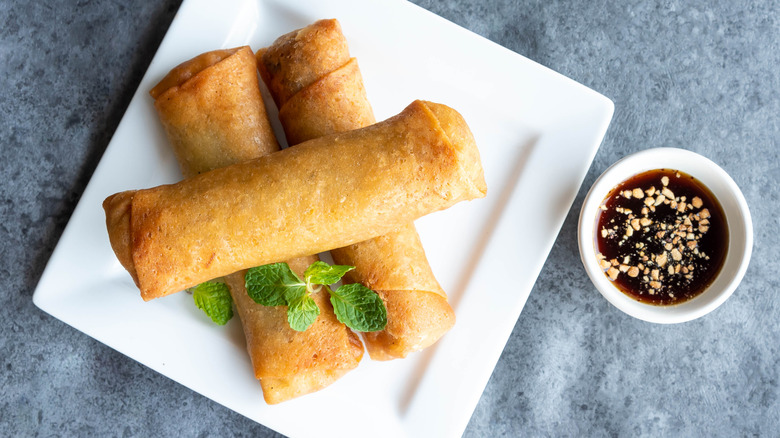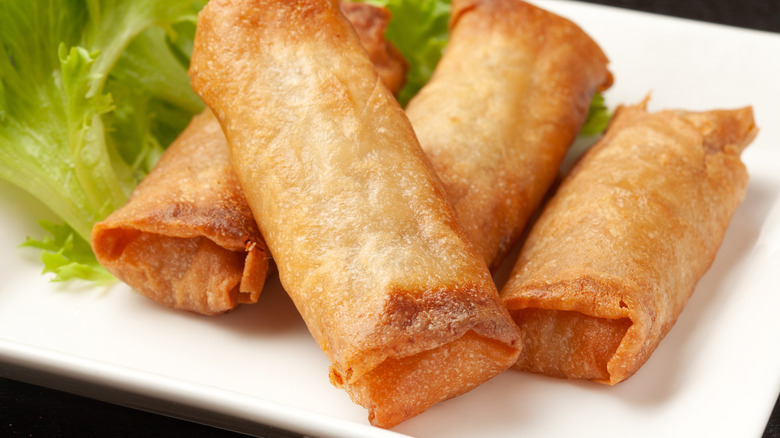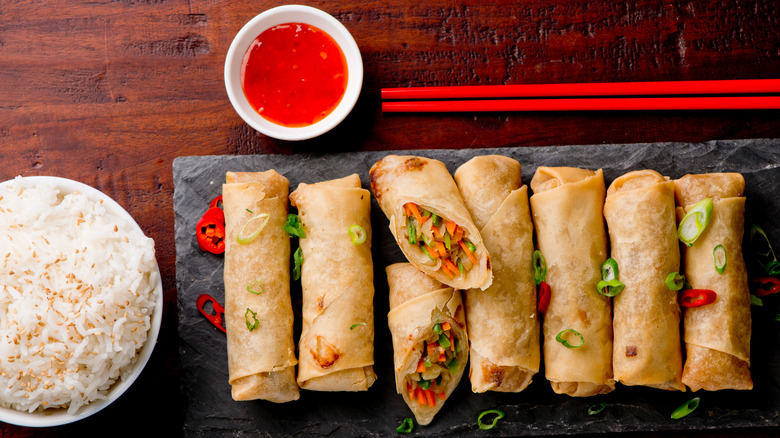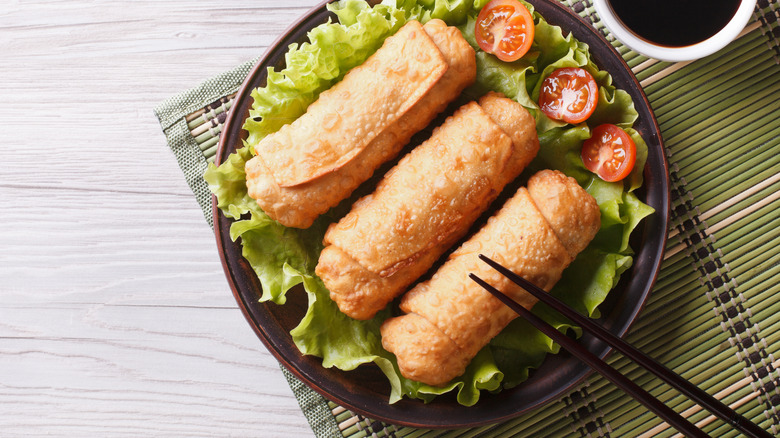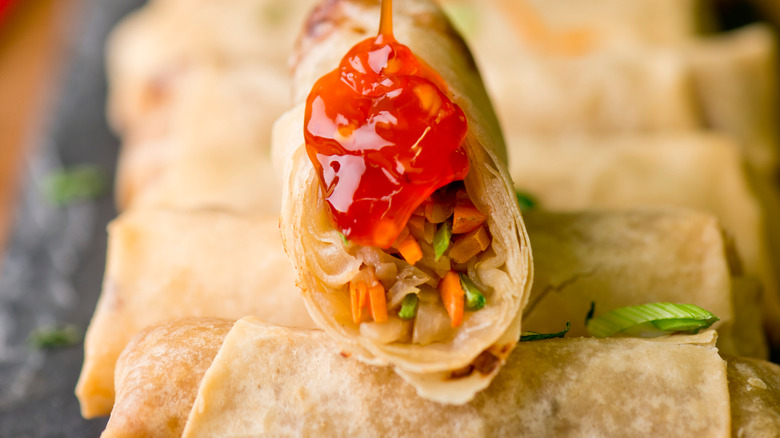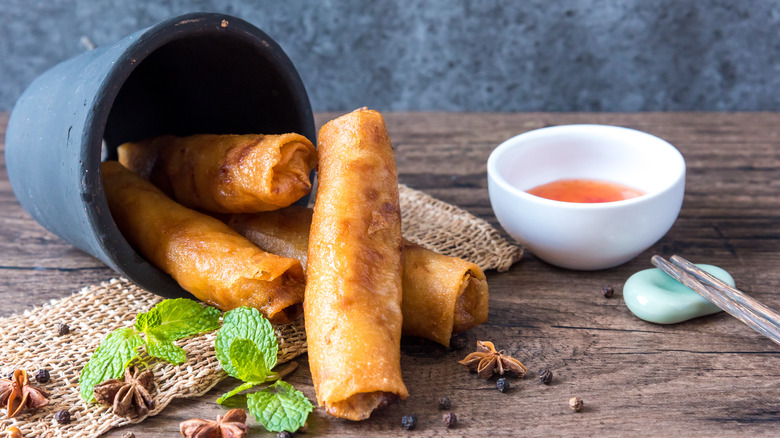The Absolute Best Ways To Reheat Egg Rolls
We may receive a commission on purchases made from links.
Like many delicious culinary treats, the origin of the egg roll is steeped in mystery. Andrew Coe, author of "Chop Suey: A Cultural History of Chinese Food in the United States," credits Henry Low, a chef at Chinatown's Port Arthur Restaurant, as the inventor of egg rolls. Coe cites Low's 1938 cookbook, "Cook at home in Chinese," which offered a recipe for the delicious appetizer, as proof of the egg roll's origins (via Wonderopolis).
However, according to Food Timeline, the egg roll likely originated in ancient China. The dough was traditionally made with wheat flour and eggs — hence the name — while its cousin, the spring roll, has a lighter wrapping made from rice paper.
Whatever way you slice it, though, a good egg roll satisfies all sorts of cravings. Bite through the deep fried crispy exterior and you're rewarded with a savory mix of finely chopped ingredients: meat and veggies (or just veggies), usually cabbage, carrots, and garlic. It's tempting to order a bunch from your favorite neighborhood Chinese joint and set them aside for a late-night snack. But Veggie Vinder explains that when egg rolls cool down after cooking, moisture forms in the pocket between the filling and the outer shell. This causes egg rolls to get soggy.
Is it possible to replicate the irresistible crunch of the egg roll's blistered crust with leftovers? Here are five ways to try.
Reheating egg rolls in a microwave
Reheating in the microwave will get the egg roll hot, but you'll forgo the crisp exterior. Kitchensnitches explains that microwaves heat the food through electromagnetic radiation. This activates water molecules in the food, causing friction. The friction heats up the food from the inside outward. While this cooking method is quick, it leaves the moisture with nowhere to go. The consequence is condensation, and a formerly crisp egg roll wrapper gone soggy.
Ravvy Reviews has some useful tips for microwaving leftover sandwiches to eliminate some sogginess that seem applicable to an egg roll, which, like a sandwich, features a wheat-based exterior with a typically meat and veg center. They suggest wrapping it in a paper towel to help absorb excess water in the food.
Livestrong.com suggests using a trivet (a microwave-safe slotted stand) to alleviate some of the sogginess. According to Purdue University, a trivet in the microwave keeps items like egg rolls as well as pizza and sandwiches dry. Reheat on high for 30 seconds (longer if they've been in the fridge), flip, and reheat for another 15 to 30 seconds, until heated through, trying not to lose too much crunch.
Reheating egg rolls in a pan or deep fryer
The Bestest Ever thinks pan frying is the way to go. This is definitely not a hands-off method, and requires additional oil, even though the egg rolls already took a dip in the deep fryer. Because of this, The Fork Bite suggests using a light hand when pouring the oil — canola is suggested — and making sure that it's hot before dropping the egg roll in the pan, lest they soak in even more oil and become soggy in the process.
High heat may over-crisp the outside, however. Once the oil heats, lower the fire under the pan to ensure the egg roll warms through without burning the delicious wrapping. Cook anywhere from five to 10 minutes, flipping continuously to cook evenly. If left cooking too long, reheating leftover egg rolls in a pan will dry out the inside. Once they're ready, remove the egg rolls from the pan and transfer to a paper towel-lined plate to absorb any excess oil.
While you can deep fry egg rolls to reheat them, testers are torn on the results. Pantry and Larder did a quick 30 to 45 second dip in 350-degree oil and still thought the double-fry made them so greasy that even the added crispness wasn't worth the excess oil. However, Battersby said deep frying gave the egg rolls a near-perfect cook, while conceding that you have to accept the extra fat and calories that go along with a second dunk.
Reheating egg rolls in an air fryer
The Kitchen Journal is partial to reheating leftover egg rolls in the air fryer because it's a quick method that retains much of the outer shell's crunch without excess oil. However, the blog cautions against air-frying frozen egg rolls, since the inside will remain ice cold. Defrost first, then put them in the appliance.
If you're cooking more than two egg rolls, make sure to leave space between them for air circulation, per Kitchensnitches. It's the warm air that heats the food, after all. Cramming items in an air fryer results in food that's not evenly cooked.
Once the egg rolls are nestled in the fryer, heat at 350 degrees for one to two minutes, depending on size (the bigger the roll, the longer the cook time). Flip and cook for another two minutes or until cooked through. Be sure to work with tongs when handling the egg rolls since the surface will be hot.
Reheating egg rolls in an oven or toaster oven
This method might be the slowest, but according to Cooking Chew, using an oven or a toaster oven is a good way to keep the egg roll's outer crust crisp without turning the inside to mush. The Foods Guy agrees, saying that this is the best technique to remedy the soggy outer shell the egg roll develops when sitting in the fridge. Give yourself plenty of time, however. Because this takes upward of 10 minutes to reheat, not including oven preheat time, it may not be the best method if you're hangry.
Cooking Chew recommends reheating the leftover egg rolls on a foil-covered baking sheet. Pop them in a preheated 350-degree oven and leave the egg rolls in for five minutes total, flipping them after two and a half. Check for doneness; the internal temperature should read 165 degrees. If your egg rolls aren't quite done, put them back in the oven for another few minutes — it shouldn't take more than five more.
Reheating egg rolls with a microwave-and-oven combo
The microwave-and-oven combo is perhaps the most complete method for reheating egg rolls. This is because the method results in the best of both worlds: a quick reheating of the savory inside and then cooking the outside with a high enough heat to re-crisp the roll but not so long that it risks burning.
Per Kitchen Portfolio, start by heating the egg rolls in the microwave on low for two minutes; you want them just warmed through. Once they are, brush or spray the leftover egg rolls lightly with oil before transferring them to a preheated 425-degree oven. Leave them to reheat in the oven for anywhere between seven to 10 minutes, flipping halfway through, until crisped.
Your patience is rewarded with a perfectly crunchy shell and a warm egg roll center that retains its moisture. In a hurry? The Fork Bite's version of this microwave-and-oven method is a bit faster, kicking things off with a 15-second blast in the microwave before reheating the egg rolls in the oven for about six minutes, turning them once to ensure each egg roll's wrapper turns crispy all the way around.
